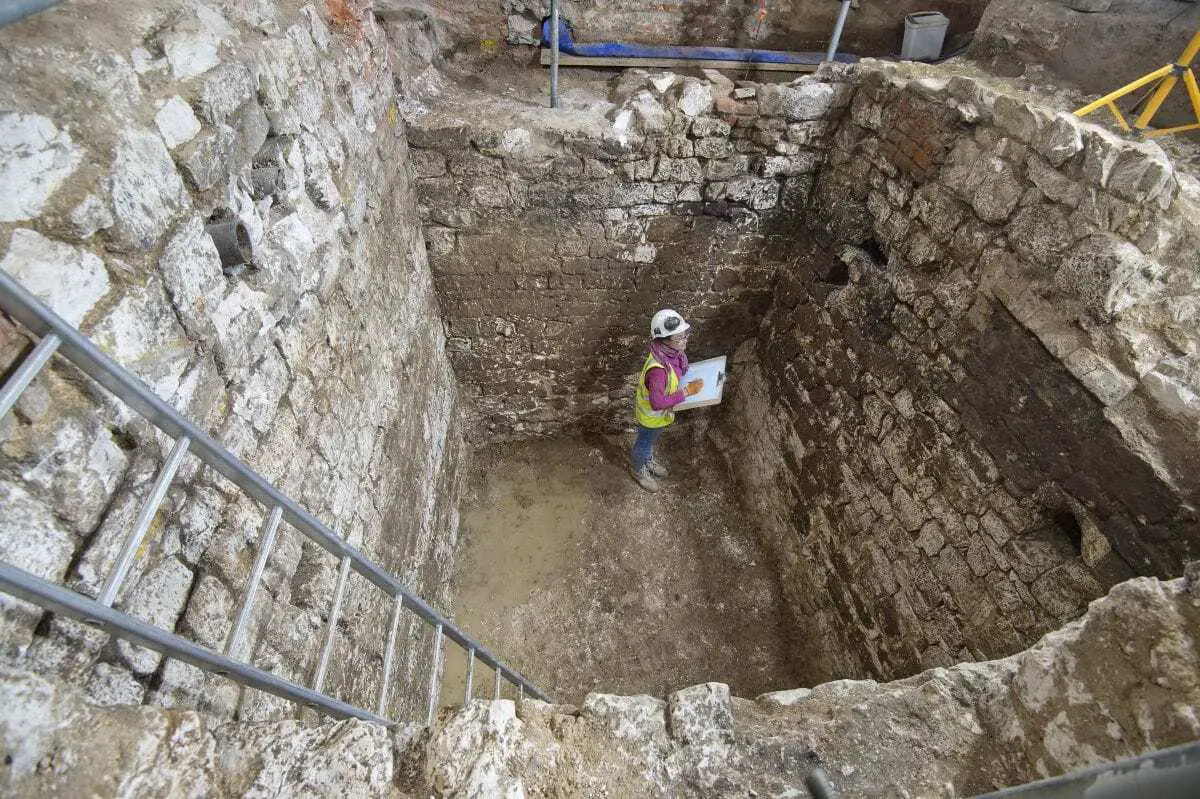Archaeologists uncover a tantalising remnant of the medieval mansions of the Strand beneath London’s Courtauld Gallery.
Where buses now rumble up and down the Strand, there once stood a row of sumptuous mansions: ‘city pads’ where regional bishops could lay their heads when in town to serve the monarch. With extensive gardens and jetties providing direct access to the Thames, these ‘millionaire mansions’ were hot property, lining the key thoroughfare which linked Westminster Palace to the City of London. These opulent properties included the Chester Inn, founded in the 15th century, which stood on the site of today’s well-known Somerset House.
Until now, relatively little has been known about these palatial residences. Historians have had to rely upon a few written sources, and a single drawing from 1543 (see below) which is thought to be largely inaccurate. Now, specialist archaeologists from MOLA (Museum of London Archaeology) excavating the basement of The Courtauld Institute of Art at Somerset House, have uncovered the first substantial physical remains of one of these mansions, in the form of an enormous medieval cesspit filled with a wide range of archaeological objects discarded over the centuries.
The location of the chalk-lined structure, which measures nearly 15 feet deep, suggests it could have been used by both the residents and visitors to the household as they entered and exited Chester Inn’s courtyard. The discovery was made during building work at The Courtauld, the world-renowned gallery and institute for the study of visual arts, which is currently undergoing an ambitious transformation thanks to the generous support of the National Lottery through £9.4m from The National Lottery Heritage Fund and donations from generous philanthropic foundations and individuals.

The project will make its world-class artworks, research and teaching facilities more accessible to wider audiences and students from around the world, whilst preserving its magnificent Grade I listed, 18th-century building at Somerset House.
Archaeologists carefully excavated the cesspit by hand over the course of a month, and it was found to contain many fascinating objects which shine a light on this poorly understood period in the development of the Strand. These include a rare 14th century ‘Penn’ floor tile – a decorating material of choice for palaces and monastic sites – pottery drinking vessels and tableware dating from the 14th and 15th centuries, as well as a range of metalwork artefacts including a finger ring, iron spur, belt buckle, bone-handled fork and pendant.
The archaeological finds have been taken to MOLA for further study and conservation, and there are plans to exhibit a selection of these artefacts at The Courtauld when its gallery reopens to the public in Spring 2021.
The discovery predates not only the current, neo-classical Somerset House designed by architect Sir William Chambers and completed in 1801, but also the Tudor palace before it, which opened around 1549 and became the residence of Princess Elizabeth I before later being demolished due to neglect.
The archaeologists also uncovered building foundations, some of which were medieval, but others dating from the Tudor period and beyond.
The Courtauld, including its celebrated collection of Impressionist and Post-Impressionist artworks, moved into the current building in 1989, and has welcomed students and art lovers from across the world for over three decades.
MOLA Senior Archaeologist, Antonietta Lerz, said: “It’s an amazing coincidence that on excavating the exact spot of the new Courtauld Gallery toilets, we found not just one, but two ‘toilet precursors’ which document the less glamorous side of almost five hundred years of luxury life alongside the Thames. It’s also remarkable that the structure remained in use for over 400 years, as the original medieval cesspit was converted into a cellar by the 17th century and a series of successive brick floors were then laid down, the latest dating to the 18th century when a small latrine was inserted in the corner. This is certainly not your typical find and represents a fascinating glimpse into the many levels and layers of history beneath the current building.”
Professor Deborah Swallow, Märit Rausing Director of The Courtauld, added: “The Courtauld is currently undergoing the most ambitious programme of development in our history, and we were fascinated to find that the building work had led to the discovery of these extraordinary objects in the foundations of our gallery. We are delighted that these discoveries will shed more light on the fascinating history of this building.
The refurbishment of The Courtauld will continue throughout this year and I look forward to welcoming back our visitors and students to The Courtauld Gallery at Somerset House in Spring 2021, where they can enjoy these remarkable artefacts and the history they reveal for themselves.”
Simon Thurley, academic and historian, former Chief Executive of English Heritage and Courtauld alumnus said: “It’s unusual to get excited about a cesspit, but this gargantuan piece of work is the only link we have found between medieval settlements on the Strand and the subsequent palace. When its contents have been fully analysed, we will begin to understand more about who built and used such an enormous pit. It’s an incredibly significant find.”
Duncan Wilson, Chief Executive, Historic England, noted: “As the first Director of the Somerset House Trust, I was excited to uncover the remarkably preserved remains of the Tudor palace, found below the Courtyard in excavations before its public opening in 2000. This latest discovery shows that Somerset House continues to surprise and amaze us by giving up secrets of London’s medieval past.
Header Image – MOLA archaeologists excavating the top of the cesspit, which had been backfilled and covered over with several layers of brick flooring © MOLA







